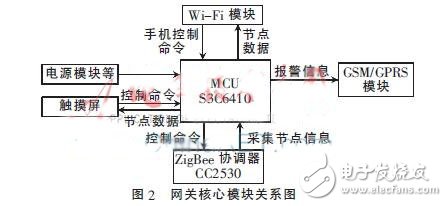The advancement of science and technology and the improvement of people's material living standards have gradually promoted the emergence of the concept of smart home. Nowadays, as one of the top ten application areas of the Internet of Things, the application of smart home is closely related to life. The continuous development of various wireless communication technologies has made the intelligent and remote control of home intelligent systems a reality. For home network communication, the amount of transmitted data is small, the transmission rate is not high, the network capacity is large, and there are many home appliances, so information is required to have real-time information, short delay, and low cost.
As an emerging wireless network communication technology, ZigBee has its advantages of low cost, low power consumption and wide coverage, making it suitable for smart home applications. In view of the complex structure of the smart home products on the market, the general performance is not strong and the user experience is not good, this paper designs and implements a more perfect smart home system.
1 system overall design
1.1 System composition
The smart home system is mainly composed of a home gateway, a ZigBee module, a GSM/GPRS module, a Wi-Fi module, a liquid crystal touch screen, various types of sensors, and a mobile phone software terminal. The home gateway is the core control part of the whole system. The ZigBee coordinator is responsible for the link of the wireless acquisition and control network, the analysis of the data and the release of the instructions. The ZigBee modules collect the environmental information and control the underlying devices according to the instructions. The overall block diagram of the system is shown in Figure 1.

The user can send control commands to the home gateway through the remote network or mobile phone software. The ZigBee coordinator controls the ZigBee modules that are responsible for collecting or controlling the home appliances. The home gateway can also provide feedback to the mobile phone software through GPRS or Wi-Fi. Equipment health and collected data. When the sensor in the home is detected to have an abnormal situation, not only the alarm in the home will start to alarm, but also the system will send an alarm message to the user's mobile phone through the GSM/GPRS module.
1.2 ZigBee network topology
There are three main types of ZigBee network topology: star, tree, and mesh. The star network has a simple structure and low cost, but the communication is limited by the distance and the coverage is small. The tree network has a route, so the coverage is larger than the star network, but once a route fails, the node connected to it is It will be disconnected from the network; the mesh network structure is complex, the coverage is large, and the reliability is high.
The star-shaped network for households with a small living area has a high cost performance. If the living area is large, the mesh network will have a better effect. The smart home system uses a star network to establish a topology.
2 system hardware design
2.1 Home Gateway Master Controller
In the design of this smart home system, the control chip of the gateway main controller adopts Samsung's S3C6410, which is a 16/32-bit RISC microprocessor, adopts ARM1176JZF-S core, and the main frequency reaches 667 MHz, which can meet the real-time system. Sexual requirements. The S3C6410 supports a TFT 24 bit LCD screen with a maximum resolution of 1 024 & TImes; 1 024. It has 2 IIC, 4 UARTs and a full-featured SPI. It also has two PCM Audio interfaces, two USB ports and an SD/MMC interface. , it is very convenient to carry out peripheral expansion. The S3C6410 is low price, high performance and low power consumption, which fully meets the design requirements. After adding peripheral circuits such as power module, GSM/GPRS module, touch screen and Wi-Fi module, the home gateway master controller is formed. The relationship between the core modules in the gateway is shown in Figure 2.

2.2 ZigBee Module
In this design, the ZigBee module is divided into two parts: the RF transceiver module and the bottom control panel.
The RF transceiver module uses the CC2530 chip from Texas Instruments as the control chip. The CC2530 chip is a true system-on-a-chip solution for IEEE802.15.4, ZigBee, and RF4CE that enables the construction of powerful network nodes with low-cost materials to support low-power wireless communications. The bottom control board is connected to the RF transceiver module, and has an 8-bit DIP switch input, 2 digital inputs, 2 digital outputs, 1 analog input, 1 analog output, and 1 IIC bus interface. Among them, the ZigBee coordinator module is connected to the home gateway through the RS232 serial port. The versatility of the underlying control board is good. According to the 8-bit DIP switch, the user can select its own function, and the user can expand the underlying node according to the requirements.
2.3 GSM/GPRS module
In this design, the GSM/GPRS module SIM300 of Chenxun Technology is adopted. The SIM300 is a complete GSM/GPRS solution in a small-volume, plug-and-play module that embeds a powerful TCP/IP protocol stack for high-speed transmission of voice, SMS, data and fax information in small size and low power consumption. . After the SIM300 is powered on, it automatically attaches to the GPRS network and establishes a communication link with the data center to send and receive data of the remote user equipment and the control center at any time. The gateway is connected to the SIM300 through the RS232 serial port, and controls the call and texting with the AT command.
Aluminium wire as a good anticorrosion material,in steel structure surface anti-corrosion(container,dam and sluice gate,ductile iron pipe,bridge etc.)
Aluminum Wire,Zinc Aluminum Wire,High Pure Aluminum Wire,Aluminum Alloy Welding Wire
Shaoxing Tianlong Tin Materials Co.,Ltd. , https://www.tianlongspray.com
